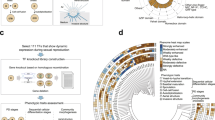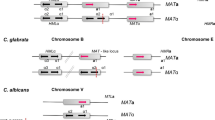Abstract
Cryptococcus neoformans is a globally distributed human fungal pathogen that causes life-threatening meningoencephalitis in immunocompromised patients1. It has a defined sexual cycle involving haploid cells of α and a mating types2, yet the vast majority of environmental and clinical isolates are α (ref. 3). Sexual recombination is normally expected to occur between isolates of opposite mating type in organisms with two mating types (or sexes). How sexual reproductive potential can be maintained in an organism with a largely unisexual, nearly clonal population genetic structure is unknown. One clue, however, is that α strains undergo fruiting, a process that resembles sexual mating4 but is thought to be strictly mitotic and asexual. We report here that hallmarks of mating occur during fruiting, including diploidization and meiosis. Pheromone response pathway elements and the key meiotic regulator Dmc1 are required for efficient fruiting. Furthermore, fusion and meiosis can occur between non-isogenic α strains, enabling genetic exchange. These studies reveal how sexual reproduction can occur between partners of the same mating type. These findings have implications for the evolution of microbial pathogens, as well as for parthenogenesis, cell fusion events and transitions between self-fertilizing and outcrossing modes of reproduction observed in both fungi and other kingdoms.



Similar content being viewed by others
References
Casadevall, A. & Perfect, J. R. Cryptococcus neoformans (ASM Press, Washington, DC, 1998)
Kwon-Chung, K. J. Morphogenesis of Filobasidiella neoformans, the sexual state of Cryptococcus neoformans. Mycologia 68, 821–833 (1976)
Kwon-Chung, K. J. & Bennett, J. E. Distribution of α and a mating types of Cryptococcus neoformans among natural and clinical isolates. Am. J. Epidemiol. 108, 337–340 (1978)
Wickes, B. L., Mayorga, M. E., Edman, U. & Edman, J. C. Dimorphism and haploid fruiting in Cryptococcus neoformans: association with the α-mating type. Proc. Natl Acad. Sci. USA 93, 7327–7331 (1996)
Hull, C. M. & Heitman, J. Genetics of Cryptococcus neoformans. Annu. Rev. Genet. 36, 557–615 (2002)
McClelland, C. M., Chang, Y. C., Varma, A. & Kwon-Chung, K. J. Uniqueness of the mating system in Cryptococcus neoformans. Trends Microbiol. 12, 208–212 (2004)
Wang, P., Perfect, J. R. & Heitman, J. The G-protein β subunit GPB1 is required for mating and haploid fruiting in Cryptococcus neoformans. Mol. Cell. Biol. 20, 352–362 (2000)
Shen, W. C., Davidson, R. C., Cox, G. M. & Heitman, J. Pheromones stimulate mating and differentiation via paracrine and autocrine signaling in Cryptococcus neoformans. Eukaryot. Cell 1, 366–377 (2002)
Rose, M. D., Price, B. R. & Fink, G. R. Saccharomyces cerevisiae nuclear fusion requires prior activation by alpha factor. Mol. Cell. Biol. 6, 3490–3497 (1986)
Hull, C. M., Davidson, R. C. & Heitman, J. Cell identity and sexual development in Cryptococcus neoformans are controlled by the mating-type-specific homeodomain protein Sxi1α. Genes Dev. 16, 3046–3060 (2002)
Marra, R. E. et al. A genetic linkage map of Cryptococcus neoformans variety neoformans serotype D (Filobasidiella neoformans). Genetics 167, 619–631 (2004)
Sauvageau, S., Ploquin, M. & Masson, J. Y. Exploring the multiple facets of the meiotic recombinase Dmc1. Bioessays 26, 1151–1155 (2004)
Mitchell, A. P. & Herskowitz, I. Activation of meiosis and sporulation by repression of the RME1 product in yeast. Nature 319, 738–742 (1986)
Thomas, C. F. Jr & Limper, A. H. Pneumocystis pneumonia. N. Engl. J. Med. 350, 2487–2498 (2004)
Matsumoto, Y. & Yoshida, Y. Sporogony in Pneumocystis carinii: synaptonemal complexes and meiotic nuclear divisions observed in precysts. J. Protozool. 31, 420–428 (1984)
Wyder, M. A., Rasch, E. M. & Kaneshiro, E. S. Quantitation of absolute Pneumocystis carinii nuclear DNA content. Trophic and cystic forms isolated from infected rat lungs are haploid organisms. J. Eukaryot. Microbiol. 45, 233–239 (1998)
Smulian, A. G., Sesterhenn, T., Tanaka, R. & Cushion, M. T. The ste3 pheromone receptor gene of Pneumocystis carinii is surrounded by a cluster of signal transduction genes. Genetics 157, 991–1002 (2001)
Shimizu, K. K. et al. Darwinian selection on a selfing locus. Science 306, 2081–2084 (2004)
Johnson, A. The biology of mating in Candida albicans. Nature Rev. Microbiol. 1, 106–116 (2003)
Grigg, M. E., Bonnefoy, S., Hehl, A. B., Suzuki, Y. & Boothroyd, J. C. Success and virulence in Toxoplasma as the result of sexual recombination between two distinct ancestries. Science 294, 161–165 (2001)
Su, C. et al. Recent expansion of Toxoplasma through enhanced oral transmission. Science 299, 414–416 (2003)
Anderson, J. B., Sirjusingh, C. & Ricker, N. Haploidy, diploidy and evolution of antifungal drug resistance in Saccharomyces cerevisiae. Genetics 168, 1915–1923 (2004)
Galitski, T., Saldanha, A. J., Styles, C. A., Lander, E. S. & Fink, G. R. Ploidy regulation of gene expression. Science 285, 251–254 (1999)
Zeyl, C., Vanderford, T. & Carter, M. An evolutionary advantage of haploidy in large yeast populations. Science 299, 555–558 (2003)
Zeyl, C. Experimental studies on ploidy evolution in yeast. FEMS Microbiol. Lett. 233, 187–192 (2004)
Vassilopoulos, G., Wang, P. R. & Russell, D. W. Transplanted bone marrow regenerates liver by cell fusion. Nature 422, 901–904 (2003)
Kwon-Chung, K. J., Edman, J. C. & Wickes, B. L. Genetic association of mating types and virulence in Cryptococcus neoformans. Infect. Immun. 60, 602–605 (1992)
Sia, R. A., Lengeler, K. B. & Heitman, J. Diploid strains of the pathogenic basidiomycete Cryptococcus neoformans are thermally dimorphic. Fungal Genet. Biol. 29, 153–163 (2000)
Fraser, J. A., Subaran, R. L., Nichols, C. B. & Heitman, J. Recapitulation of the sexual cycle of the primary fungal pathogen Cryptococcus neoformans var. gattii: implications for an outbreak on Vancouver Island, Canada. Eukaryot. Cell 2, 1036–1045 (2003)
Toffaletti, D. L., Rude, T. H., Johnston, S. A., Durack, D. T. & Perfect, J. R. Gene transfer in Cryptococcus neoformans by use of biolistic delivery of DNA. J. Bacteriol. 175, 1405–1411 (1993)
Acknowledgements
We thank W.-C. Shen for strains, A. Mitchell, J. Fraser and A. Idnurm for discussions, and T. Mitchell, D. Lew, B. Capel, R. Wharton and J. Anderson for critical reading. This work was supported by an NIAID R01 grant to J.H. C.M.H. was supported by a Damon Runyon Cancer Research Fellowship and a Burroughs Wellcome Career Development Award in the Biomedical Sciences. J.H. is a Burroughs Wellcome Fund Scholar in Molecular Pathogenic Mycology and an Investigator of the Howard Hughes Medical Institute.
Author information
Authors and Affiliations
Corresponding authors
Ethics declarations
Competing interests
The authors declare that they have no competing financial interests.
Supplementary information
Supplementary Notes
This file contains Supplementary Data, Supplementary Methods, Supplementary Figure Legend and additional references. (DOC 41 kb)
Supplementary Figure S1
Dikaryotic mating hyphae contain two nuclei per compartment that alternate position at each conjugate division. (PDF 23 kb)
Rights and permissions
About this article
Cite this article
Lin, X., Hull, C. & Heitman, J. Sexual reproduction between partners of the same mating type in Cryptococcus neoformans. Nature 434, 1017–1021 (2005). https://doi.org/10.1038/nature03448
Received:
Accepted:
Issue Date:
DOI: https://doi.org/10.1038/nature03448
- Springer Nature Limited
This article is cited by
-
ASF1 regulates asexual and sexual reproduction in Stemphylium eturmiunum by DJ-1 stimulation of the PI3K/AKT signaling pathway
Fungal Diversity (2023)
-
Regulatory basis for reproductive flexibility in a meningitis-causing fungal pathogen
Nature Communications (2022)
-
An analysis of the population of Cryptococcus neoformans strains isolated from animals in Poland, in the years 2015–2019
Scientific Reports (2021)
-
A cyclin protein governs the infectious and sexual life cycles of Cryptococcus neoformans
Science China Life Sciences (2021)
-
Transcription factor Znf2 coordinates with the chromatin remodeling SWI/SNF complex to regulate cryptococcal cellular differentiation
Communications Biology (2019)





